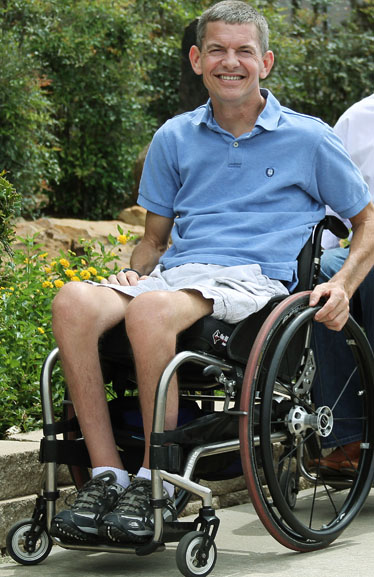My name is Bill, and I worked for 180 Medical for over 10 years. About 26 years ago, I was involved in a motocross accident that rendered me a quadriplegic. You can learn more about my story here. Since then, I’ve been able to use my experiences to help and counsel others who are also adapting to life after a spinal cord injury.

Bill’s Top Tips for Adapting After a Spinal Cord Injury
As a C5-6 quadriplegic, I’d like to share a few helpful tips for anyone living with an SCI, particularly those new to their injury and recently released from their rehabilitation center.
1. Plan a daily routine.
While in rehabilitation therapy, my fellow patients and I were woken up every day at 6:00 a.m. and kept to an orderly schedule until bedtime. This is because having a routine can help establish a sense of dependable structure after a spinal cord injury, which alters your life in so many ways.
Therefore, I recommend trying to stick to something similar or creating a daily routine of your own. When we create positive habits, it can truly enhance your life and help you adapt to life with a spinal cord injury. Especially in early recovery after you’re released, having too much extra time without a schedule or tasks to do can lead to depression. Find something you love to do or participate in, create a routine, and eventually, it will become a habit.
Important note: Be sure to continue your bowel and bladder management program as your physician has prescribed, which may include the use of catheters.
2. Exercise after your spinal cord injury.
 Exercise isn’t just important for maintaining your health. It’s also important for maintaining or losing weight. You may find out that it’s not uncommon for those with spinal cord injuries to gain weight due to inactivity. However, it’s important to try your best to stay in shape.
Exercise isn’t just important for maintaining your health. It’s also important for maintaining or losing weight. You may find out that it’s not uncommon for those with spinal cord injuries to gain weight due to inactivity. However, it’s important to try your best to stay in shape.
In addition, exercise may also help you regain your independence. With regular exercise, you may find it gets easier to do wheelchair transfers and other daily activities.
When you return home after your release, you might not have access to all the necessary equipment at home. It might be worth checking with your rehabilitation center to see if they offer continuing outpatient-based visits, so you can continue to use their equipment or get assistance with workouts. You might also check with your local gym or fitness center, as they might also have adaptive equipment.
Equipment and Exercises to Consider
While in rehabilitation therapy, you may have been taught a daily spinal cord injury exercise routine. I was given weights and resistance bands, and they also taught me how to perform wheelchair pushes.
For exercising at home, you may find that resistance bands are a great help because they’re not only very effective but inexpensive as well. You can also purchase hand weights or even wristband weights if you have limited hand dexterity like me.
Continuing to work on pushing your own wheelchair (if you are physically able) is also of great importance. When I first returned home, I would spend an hour during the day pushing my chair as long and hard as I could. At first, I could barely push up a ramp, but with continued effort, I was able to push on my own for a few miles, which was a huge success! I also made sure to keep going to my local rehab center at least three times a week to lift weights and resistance train.
3. Eat well to maintain health after a spinal cord injury.
In addition to exercise, maintaining a healthy diet is also important to your health. Your rehabilitation therapist or healthcare professional may be able to counsel you on the best foods for your health or refer you to a certified nutritionist to formulate a specialized diet for you.
4. Consider going back to school or work.
Life doesn’t have to stop just because of your spinal cord injury. You can go back to school or work, which also helps with having a daily routine and schedule.
If you already had a job before your injury and are planning on returning to work after rehab, your employer should assist you in making any necessary accommodations, so you can continue to work for them.
If you are interested in trying to go back to work or plan on working in the future, get in contact with your local Department of Rehabilitation Services. DRS may assist your job search and can also provide you with accommodations you might need in order to work.
Additionally, they can also assist you in making a plan for any continuing education. Fortunately, they also often offer resources that may help pay for all or part of your education costs.
School and Scholarships After Spinal Cord Injury
Most schools and universities have a department specifically to assist those of us with disabilities. They help make sure that your classes are accessible for you, and if you have any other special needs, they can work to make the necessary accommodations for you. Examples of this could range from getting someone to assist you in taking notes to get a classroom location changed if the original classroom is not physically accessible.
Also, many scholarship opportunities are out there for those of us with disabilities, including 180 Medical’s annual college scholarship program.
I knew a young man who had done construction work all of his life. After breaking his back, he realized that he would no longer be able to do that type of work anymore. He decided to go back to school went back to school, ended up becoming an attorney, and has been very successful.
No matter what you were doing before you had your spinal cord injury, the sky is the limit on what you can do in the future. While it took me a while before I was able to get my first job, I was so grateful to finally have a daily purpose with going to work, because I was starting to get depressed by not doing anything. No matter what your level of injury is, see what job options might be available to you if that is of interest.
5. Join a local or virtual spinal cord injury support group.
I can’t say enough good things about support groups. These meetings can be so beneficial. Not only does it allow you to share ideas with people who are going or have gone through the same things, but some of my best friends today are people I met through my local support group.
Most states, cities, or larger towns have spinal cord injury support group meetings or an association of some sort. For example, I’m originally from a small town of approximately 15,000 people, and even there, we had a group that met every month. There were not that many of us, but it was nice to meet people in my area with similar disabilities and understood some of the issues I was also encountering. If you live in a rural area, you might have to travel to get to the nearest meeting. The Spinal Cord Association in Oklahoma City offers their meetings by Skype so that people who are unable to make it to the meeting can still participate. If there is not already a support group in your area yet, you might consider starting one.
6. Use available online resources for spinal cord injuries.
There is a wealth of information available to you on the internet, from educational information, community activities, local support groups, helpful webinars, adaptive equipment and clothing, charitable associations, and more. If you have found this article, then you already know what I mean.
I have written several blogs for 180 Medical discussing all types of issues which you may also find helpful, all the way from achieving independence as a quadriplegic, traveling, adaptive clothing for people in wheelchairs, and even my experience with adaptive sports like kayaking.
Some great resources to start:
Christopher & Dana Reeve Foundation
National Spinal Cord Injury Association (United Spinal)
Progressive Independence
DREAM (Disability Rights, Education, Activism, and Mentoring)
Dream2Walk
Triumph Foundation
Facing Disability
7. Start driving again.
For me, personally, getting behind the wheel again was the biggest step in feeling as if I had gained my independence back. While I know that some people have too great a level of injury to be able to drive themselves, many others are still able to do so.
Most paraplegics are able to transfer into a car or truck, break their wheelchair down, and load it into their vehicle, so the only modifications they may require are hand controls and possibly a steering wheel knob. These modifications are usually under a few thousand dollars. As a quadriplegic, I require a van with a lift, automatic door openers, a 6-way seat base, hand controls, and a tri-pin on my steering wheel. These adaptive modifications to one’s vehicle can end up being very costly, however. There are more types of modifications available.
Ready to get back to work? The Department of Rehabilitation Services might help pay for the disability modifications. However, keep in mind you’re responsible for paying for your vehicle.
Also, if you’re planning on buying a new vehicle, many manufacturers offer assistance for paying for your adaptive equipment modifications.
8. Participate in adaptive sports and recreation.
 Whether you want to professionally compete in sports or just enjoy doing something for fun, there are so many options available to you, both indoors and outdoors.
Whether you want to professionally compete in sports or just enjoy doing something for fun, there are so many options available to you, both indoors and outdoors.
I personally enjoy swimming, kayaking, riding my hand-crank bike, water-skiing, and I even went snow-skiing once but haven’t had the opportunity to go back yet.
Check your local resources and give the internet a quick search to see what is available.
A few helpful organizations and informational websites:
Life Rolls On (Surf and Skating events)
National Wheelchair Basketball Association
VA Adaptive Sports (US Department of Veterans Affairs)
Disabled Sports USA (this includes local chapters and youth programs as well)
Blaze Sports America
Christopher & Dana Reeve Foundation information on Team Sports
Paralyzed Veterans of America Sports
Oklahoma Adaptive Sports Association (OKASA)
U.S. Paralympics
9. Never give up.
Above all, don’t lose hope! Life is not over for you, even if it has been drastically changed by your injury. Help is available out there!
Lastly, as someone who has been where you are right now, I wish you all the best on your new journey. I truly encourage you to reach out for any support you may need at this crucial time in your life.